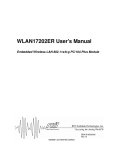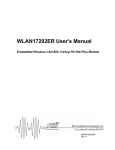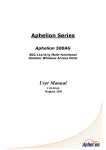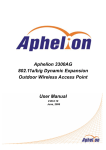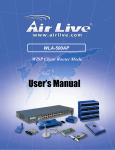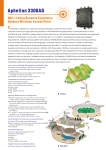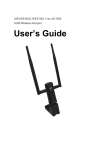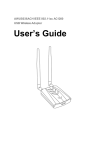Download IEEE802.11a+g Access Point with PoE User's Guide
Transcript
IEEE802.11a+g Access Point with PoE User’s Guide Version 1.0 Aug. 2005 Copyright Statement No part of this publication may be reproduced, stored in a retrieval system, or transmitted in any form or by any means, whether electronic, mechanical, photocopying, recording or otherwise without the prior writing of the publisher. Windows® 98/ME/2000/XP are trademarks of Microsoft® Corp. All copyright reserved. 1 Table of Contents 1. INTRODUCTION 5 1.1 FEATURES 1.2 PACKAGE CONTENTS 1.3 SYSTEM REQUIREMENTS 1.4 WIRELESS NETWORK SCENARIOS AS AN ACCESS POINT AS A STAND-ALONE REPEATER AS A POINT TO MULTI-POINTS BRIDGE 5 5 5 6 6 7 7 2. HARDWARE INSTALLATION 8 2.1 APPEARANCE 2.2 HARDWARE CONNECTION 8 9 3. ETHERNET / WLAN CLIENT 10 4. ACCESS WEB-BASED UTILITY 12 5. SETUP WIZARD 13 5.1 TIME SETTINGS 5.2 DEVICE IP SETTINGS 5.3 WIRELESS SETTINGS 5.3.1 SECURITY-WEP 5.3.2 802.1X 5.3.3 WPA-PSK / WPA2-PSK 5.3.4 WPA / WPA2 13 14 15 17 18 19 20 5.4 SAVE CONFIG 21 6. ADVANCED SETTINGS 22 6.1 PASSWORD SETTINGS 6.2 SYSTEM MANAGEMENT 6.3 SNMP SETTINGS 6.4 MAC FILTERING SETTINGS 22 23 25 27 2 6.5 WIRELESS SETTINGS 6.6 OPERATIONAL MODE 6.7 RADIUS SETTINGS 28 30 31 7. DEVICE STATUS 33 7.1 SYSTEM LOG 7.2 WIRELESS CLIENT TABLE 7.3 BRIDGE TABLE 34 35 35 8. SYSTEM TOOLS 36 8.1 FIRMWARE UPGRADE 8.2 CONFIGURATION SAVE OR RESTORE 8.3 FACTORY DEFAULT 8.4 REBOOT 9 HELP 36 37 38 38 39 9.1 WHAT IF YOU FORGOT THE PASSWORD? 10. SPECIFICATION 39 40 3 Regulatory Information Federal Communication Commission Interference Statement This equipment has been tested and found to comply with the limits for a Class B digital device, pursuant to Part 15 of the FCC Rules. These limits are designed to provide reasonable protection against harmful interference in a residential installation. This equipment generates, uses and can radiate radio frequency energy and, if not installed and used in accordance with the instructions, may cause harmful interference to radio communications. However, there is no guarantee that interference will not occur in a particular installation. If this equipment does cause harmful interference to radio or television reception, which can be determined by turning the equipment off and on, the user is encouraged to try to correct the interference by one of the following measures: - Reorient or relocate the receiving antenna. - Increase the separation between the equipment and receiver. - Connect the equipment into an outlet on a circuit different from that to which the receiver is connected. - Consult the dealer or an experienced radio/TV technician for help. FCC Caution: To assure continued compliance, (example - use only shielded interface cables when connecting to computer or peripheral devices) any changes or modifications not expressly approved by the party responsible for compliance could void the user’s authority to operate this equipment. This device complies with Part 15 of the FCC Rules. Operation is subject to the following two conditions: (1) This device may not cause harmful interference, and (2) this device must accept any interference received, including interference that may cause undesired operation. IMPORTANT NOTE: FCC Radiation Exposure Statement: This equipment complies with FCC radiation exposure limits set forth for an uncontrolled environment. This equipment should be installed and operated with minimum distance 20cm between the radiator & your body. This transmitter must not be co-located or operating in conjunction with any other antenna or transmitter. 4 1. Introduction 1.1 Features High performance 11 Mbps (802.11b) or 54Mbps (802.11a/g) data rate Wi-Fi, WPA certificated interoperability WDS (Wireless Bridge) mode support Repeater Mode support (Wireless Repeater) WPA with PSK/TKIP/AES support WPA2 support 152-bit WEP support (Atheros Proprietary) Super A/G™ mode support (Atheros Proprietary) Support adjustable output power IEEE 802.3af (PoE) compliance Privacy Separator support SNMP v1/v2 support ACKTimeOut setting User Limitation (Static Load Balancing) 1.2 Package Contents One 802.11A+G ACCESS POINT One 5V AC power adapter with a barrel connector CD of the 802.11A+G ACCESS POINT User’ Guide Two Reverse SMA Antennas 1.3 System Requirements PC (equipped with Ethernet network card or wireless adapter and has appropriate network card driver and TCP/IP installed) Windows® 98/SE/2000/XP RJ-45 Ethernet Cable 5 1.4 Wireless Network Scenarios A group of wireless stations communicating with each other is called a Basic Service Set (BSS) and is identified by a unique SSID. When an 802.11A+G ACCESS POINT is used, it can be configured to operate in the following three network configurations As An Access Point When configured in the Access Point mode, the 802.11A+G ACCESS POINT allows a group of wireless stations to communicate with each other through it. Such a network is called an Infrastructure BSS. The 802.11A+G ACCESS POINT further provides bridging functions between the wireless network and the wired LAN network. When multiple access points are connected to the same LAN segment, stations can roam from one 802.11A+G ACCESS POINT to another without losing their connections, as long as they are using the same SSID. This is shown in the diagram below. 6 As A Stand-Alone Repeater The purpose of a repeater is to expand an existing infrastructure BSS. When configured to operate in the Repeater Mode, the 802.11A+G ACCESS POINTs sit between wireless stations and a “root” AP whose BSS is being expanded, as shown below: As A Point to Multi-Points Bridge When configured to operate in the Wireless Distribution System (WDS) Mode, the 802.11A+G ACCESS POINT provides bridging functions between the LAN behind it and separate LANs behind other AP’s operating in the WDS mode. The system will support up to eight such AP’s in a WDS configuration. Note that an 802.11A+G ACCESS POINT running in the WDS mode can also support wireless stations simultaneously, as shown in the left most AP in the diagram below: 7 2. Hardware Installation 2.1 Appearance ANTENNA POWER RESET LAN POWER: RESET: Power connector. Resets the AP to factory defaults. Insert a straightened paperclip into the hole to press the button. Press and hold for about 2~5 seconds, and then wait for the AP to finish booting. LAN: Lan cable connector. LED Description 11a 11b/g 100M LINK/ACT Power Status On OFF Blinking Wireless Link is activated No Wireless connection Transmit / Receive Data LAN Link is activated No LAN connection Transmit / Receive Data 8 Power Power No Power 2.2 Hardware Connection 1 Choose a place for the AP. (1) Locate the AP at the center of your wireless network for better coverage of the wireless stations. (2) Adjust the direction of the antennas. 2 Connect the cables. (1) Connect the power cable. (2) Connect one end of the Ethernet cable to the AP and the other end to the PC. LAN POWER Electrical Outlet PC 9 3. Ethernet / WLAN Client You can access the AP’s Web interface via Ethernet or wireless network. Before doing so, you have to make sure that your PC is on the same subnet with the AP. The AP’s default settings are: IP Address: 192.168.1.1 Subnet Mask: 255.255.255.0 DHCP server: Disabled Therefore, you need a static IP for your PC’s TCP/IP settings: IP Address: 192.168.1.* (* is a number between 2~254) Subnet Mask: 255.255.255.0 Follow the steps below to configure a static IP for your PC. Later, if you enable the AP’s DHCP server, you may set your PC to be a DHCP client. 1 Set up TCP/IP for your PC. For Windows 98/ME (1) Click Start→Settings→Control Panel. (2) (3) (4) (5) (6) (7) Double click “Network”. Select “TCP/IP” protocol and click “Properties”. On the IP Address tab, select “Specify an IP address”. Enter the IP address and subnet mask. Select Gateway tab and set the gateway value. Click “OK” twice to save the new settings. Restart your PC if necessary. For Windows 2000/XP (1) Click Start→Settings→Control Panel. (2) Double click “Network Dial-up Connections” or “Network Connections”. (3) Right click “Local Area Connection” and select “Properties”. (4) Select “Use the following IP address” and enter the IP settings. (5) Click “OK” when finished. 2 Set up wireless client. If you choose to wirelessly access the AP, be sure your PC is equipped with 802.11a or 802.11b or 802.11g wireless devices. If you found that your wireless device cannot communicate with the AP, even the link status 10 indicates a successful connection, make sure the following settings are properly configured. Operation Mode: Infrastructure SSID: wlan Authentication: Open Encryption: None 11 4. Access Web-Based Utility 1 Be sure the AP is installed and PC is configured properly. Make sure you have followed steps described in Chapter 2 and Chapter 3 for Hardware Installation and PC Configuration. 2 Open the Web browser and type http://192.168.1.1 in URL field. This address is the default IP of the AP. 3 Utility window appears. Click “Setup Wizard”. 4 Log-on page appears. Enter “password”, and click “LOG ON”. The default password is “password”. The password you entered is displayed as a string of dots. 5 See Chapter 5~Chapter 9 for using the Configuration Utility. You may click “Help” to get help with commonly asked questions about the AP. 12 5. Setup Wizard The Setup Wizard will guide you through a series of configuration screens to set up the basic functionality of the device. After you finish the settings, remember to press the “FINISH” button for the settings to take effect. See Chapter 5.4 Save Config for details. 5.1 Time Settings After logging in, the time settings page appears. The device time is automatically set to the local time of the management PC at the first time a connection is made. To modify the device’s time, modify the appropriate fields, then click NEXT. 13 5.2 Device IP Settings The Device IP Settings screen allows you to configure the IP address and subnet of the device. Although you can rely on a DHCP server to assign an IP address to the 802.11A+G ACCESS POINT automatically, it is recommended that you configure a static IP address manually in most applications. If you choose to assign the IP address manually, check the button that says “Assign static IP to this device” and then fill in the following fields IP Address and IP Subnet Mask: These values default to 192.168.1.1 and 255.255.255.0, respectively. It is important to note that there are similar addresses falling in the standard private IP address range and it is an essential security feature of the device. Because of this private IP address, the device can no longer be accessed (seen) from the Internet. Gateway IP Address: Enter the IP address of your default gateway. DNS Server: The Domain Name System (DNS) is a server on the Internet that translates logical names such as “www.yahoo.com” to IP addresses like 66.218.71.80. In order to do this, a query is made by the requesting device to a DNS server to provide the necessary information. If your system administrator requires you to manually enter the DNS Server addresses, you should enter them here. 14 If you choose to use a DHCP Server to acquire an IP address for the 802.11A+G Access Point automatically, check the button that says, “Use the DHCP protocol to automatically get the IP address for this device”. Again, as a reminder, it is recommended that your 802.11A+G ACCESS POINT should be assigned a static IP address in order to make it easy for you to manage the device later on. 5.3 Wireless Settings Network Name (SSID): The SSID is the network name used to identify a wireless network. The SSID must be the same for all devices in the wireless network (i.e. in the same BSS). Several access points on a network can have the same SSID. The SSID length is up to 32 characters. The default SSID is “wlan”. Disable SSID Broadcasting: An access point periodically broadcasts its SSID along with other information, which allows client stations to learn its existence while searching for access points in a wireless network. Check Disable if you do not want the device to broadcast the SSID. 15 The wireless module is IEEE 802.11g and 802.11b compliant, and choosing “11g/b” allows both 802.11b and 802.11g client stations to get associated. However, choosing “11g” allows only 802.11g client stations to get associated and get better overall performance. 802.11a is not Mode (WLAN Mode): compliant with either 802.11b or 802.11g; choosing “11a” only allows 802.11a client stations to get associated. The same explanation for both of the radios. Channel: Select a channel from the available list to use. All devices in a BSS must use the same channel. You can select Auto to let the system pick up the best channel for you. Note! The available channels are different from country to country and for different WLAN mode. Security Policy: You can select different security policy to provide association authentication and/or data encryption. See Chapter 5.3.1~Chapter 5.3.4 for details. 16 5 . 3 . 1 S e c u r i t y- W E P WEP allows you to use data encryption to secure your data from being eavesdropped by malicious people. It allows 3 types of key: 64 (WEP64), 128 (WEP128), and 152 (WEP152) bits. You can configure up to 4 keys using either ASCII or Hexadecimal format. Key Settings (WEP Key 1~4): The length of a WEP64 key must be equal to 5 bytes, a WEP128 key is 13 bytes, and a WEP152 key is 16 bytes. For WEP64 and WEP128, you can just enter a pass-phrase and click the GENERATE button to generate the four keys. So you can use a mnemonic string as the pass-phrase instead of memorizing the four keys. Key Index: You have to specify which of the four keys will be active. Once you enable the WEP function, please make sure that both the 802.11A+G ACCESS POINT and the wireless client stations use the same key. Note! Some wireless client cards only allow Hexadecimal digits for WEP keys. Please note that when configuring WEP keys, a WEP128 ASCII key looks like “This is a key”(13 characters), while a WEP128 Hex key looks like “54-68-69-73-20-69-73-20-61-20-6b-65-79”(13 bytes). 17 5.3.2 802.1x 802.1x allows users to leverage a RADIUS server to do association authentications. You can also enable dynamic WEP keys (64, 128, 152-bit) to have data encryption. Here you do not have to enter the WEP key manually because it will be generated automatically and dynamically. Note! After you have finished the configuration wizard, you have to configure the Radius Settings in Advanced Settings in order to make the 802.1x function work. 18 5.3.3 WPA-PSK / WPA2-PSK Wi-Fi Protected Access (WPA) with Pre-Shared Key (PSK) provides better security than WEP keys. It does not require a RADIUS server in order to provide association authentication, but you do have to enter a shared key for the authentication purpose. The encryption key is generated automatically and dynamically. Pre-shared Key: This is an ASCII string with 8 to 63 characters. Please make sure that both the 802.11A+G ACCESS POINT and the wireless client stations use the same key. Encryption Type: There are two encryption types TKIP and CCMP (AES). While CCMP provides better security than TKIP, some wireless client stations may not be equipped with the hardware to support it. You can select Both to allow TKIP clients and CCMP clients to connect to the Access Point at the same time. Group Rekey Interval: A group key is used for multicast/broadcast data, and the rekey interval is time period that the system will change the group key periodically. The shorter the interval is, the better the security is. 60 seconds is a reasonable time, and it is used by default. 19 5.3.4 WPA / WPA2 Wi-Fi Protected Access (WPA) requires a RADIUS server available in order to do authentication (same as 802.1x), thus there is no shared key required. The Encryption Type and Group Rekey Interval settings are same as WPA-PSK’s. 20 5.4 Save Config If you make changes on the web-based configuration utility, remember to press the FINISH button for your modification to take effect. This also makes your new settings saved into the permanent memory on your system. Congratulations! You are now ready to use the 802.11A+G ACCESS POINT. Note! If you change the device’s IP address, as soon as you click on FINISH you will no longer be able to communicate with your 802.11A+G ACCESS POINT. You need to change your IP address and then re-boot your computer in order to resume the communication. 21 6. Advanced Settings The Advanced Settings tab on the top row of the window allows you to perform modifications that normally you may not need to do for general operations except changing your password from the default factory setting (this is highly recommended for security purposes). 6.1 Password Settings The default factory password is “password”. To change the password, press the Password Settings button to enter the Password Settings screen, then enter the current password followed by the new password twice. The entered characters will appear as asterisks. 22 6.2 System Management Clicking the System Management button to configure system related parameters to for the 802.11A+G ACCESS POINT. Local Management: Choose whether to disable the management from wireless client or not. Management Session Time-out: This setting specifies the duration of idle time (inactivity) before a web browser or telnet management session times out. The default time-out value is 10 minutes. UPnP: The Universal Plug and Play (UPnP) feature allows a Windows XP/ME PC to discover this 802.11A+G Access Point and automatically show an icon on the screen. Then a user can double-click the icon to access this 23 device directly (without having to find out its IP address). Syslog: Syslog is an IETF (Internet Engineering Task Force - the Internet standards body)-conformant standard for logging system events (RFC-3164). When the 802.11A+G ACCESS POINT encounters an error or warning condition (e.g., a log-in attempt with an invalid password), it will create a log in the system log table. To be able to remotely view such system log events, you need to check the Enable Syslog box and configure the IP address of a Syslog daemon. When doing so, the 802.11A+G ACCESS POINT will send logged events over network to the daemon for future reviewing. Syslog server IP address: The IP address of the PC where the Syslog daemon is running. Email Log: Choose whether or not to enable Email Log. If enabled, enter the email server and email address. 24 6.3 SNMP Settings Click SNMP Settings to configure SNMP Community. SNMP (Simple Network Management Protocol) is a widely used network monitoring and control protocol. SNMP works by sending messages, Protocol Data Units (PDUs), to different parts of a network. SNMP-compliant devices, called agents, store data about themselves in Management Information Bases (MIBs) and return this data to the SNMP requests. Enable SNMP: Choose whether or not to enable SNMP. System Information: Enter the Name, Location and Contact persons for SNMP manager. Community String: Access to the SNMP device is controlled through community strings. Community strings can be thought of as passwords. If you don’t have the correct community strings, you cannot retrieve any data or 25 make any changes. or for Write. Community strings can control the access rights: for Read Name and IP Address: Enter Name and IP Address for SNMP trap manager. SNMP Trap: The Access point receives SNMP Traps from network equipment (routers, switches and workstations). Traps are sent when errors or specific events occur on the network. Traps are normally only sent to end stations which are currently sending SNMP requests to the device in question. 26 6.4 MAC Filtering Settings The 802.11A+G ACCESS POINT allows you to define a list of MAC addresses that are allowed or denied to access the wireless network To add a MAC address into the table, enter a mnemonic name and the MAC address, and then click ADD. The table lists all configured MAC Filter entries. To delete entries, check the corresponding select boxes and then press DELETE SELECTED. Disable MAC address control list: When selected, no MAC address filtering will be performed. Enable GRANT address control list: When selected, data traffic from only the specified devices in the table will be allowed in the network. Enable DENY address control list: When selected, data traffic from the devices specified in the table will be denied/discarded by the network. 27 6.5 Wireless Settings Beacon Interval: The 802.11A+G ACCESS POINT broadcasts beacon frames regularly to announce its existence. The beacon Interval specifies how often beacon frames are transmitted - in time unit of milliseconds. The default value is 100, and a valid value should be between 1 and 65,535. RTS Threshold: RTS/CTS frames are used to gain control of the medium for transmission. Any unicast (data or control) frames larger than specified RTS threshold must be transmitted following the RTS/CTS handshake exchange mechanism. The RTS threshold should have a value between 1-2347 bytes, with a default of 2347. It is recommended that this value does not deviate from the default too much. 28 Fragmentation Threshold: When the size of a unicast frame exceeds the fragmentation threshold, it will be fragmented before the transmission. It should have a value of 256-2346 bytes, with a default of 2346. If you experience a high packet error rate, you should slightly decrease the Fragmentation Threshold. DTIM Interval: The 802.11A+G ACCESS POINT buffers packets for stations that operate in the power-saving mode. The Delivery Traffic Indication Message (DTIM) informs such power-conserving stations that there are packets waiting to be received by them. The DTIM interval specifies how often the beacon frame should contain DTIMs. It should have a value between 1 to 255 with a default value of 3. Enable privacy separator for 2 radio: enable/disable. Radio 1/Radio 2 Transmit Power: 100%, 75%, 50%, 25%, 12%. Age Out Timer: Ranges from 10 to 65535 seconds. The default is 300. AckTimeOut: Ranges from 10 to 255. The default is 25. AckTimeOut (Turbo-11a): Ranges from 10 to 255. The default is 22. AckTimeOut(11g): Ranges from 10 to 255. The default is 48. AckTimeOut(Turbo-11g): Ranges from 10 to 255. The default is 22. 29 6.6 Operational Mode The 802.11A+G ACCESS POINT can be configured to operate in one of the following two modes as mentioned previously in Chapter 1.4 Wireless Network Scenarios: (1) Access Point (2) Wireless Distribution System (Bridge Mode) When configured as a Bridge, you need to further configure the name and MAC address of its peer Wireless Distribution System devices. 30 6.7 Radius Settings Radius servers provide centralized authentication services to wireless clients. Two user authentication methods can be enabled: one based on MAC address filter, the other based on 802.1x EAP authentication. MAC address filtering based authentication requires a MAC address filter table to be created in either the 802.11A+G ACCESS POINT (as described in the Chapter 6.4 MAC Filtering Settings) and/or the Radius server. During the authentication phase of a wireless station, the MAC address filter table is searched for a match against the wireless client’s MAC address to determine whether the station is to be allowed or denied to access the network. The Radius server can also be used for 802.1x EAP authentication. IEEE 802.1x is an IEEE standard that is based on a framework that involves stations to be authenticated (called Supplicant), an authentication server (a Radius Server) that provides authentication services, and an authenticator that provides necessary translation and mediating functions between the authentication server and the stations to be authenticated. The 802.11A+G ACCESS POINT acts as an authenticator, and it relays authentication messages between the RADIUS server and client devices being authenticated. IEEE 802.1x EAP authentication is enabled by selecting the Security Policy as 802.1x or WPA (see Chapter 5.3 Wireless Settings). 31 Enable Radius Server: Check this option to enable RADIUS server. Server IP: The IP address of the RADIUS server Port Number: The port number that your RADIUS server uses for authentication. The default setting is 1812. Shared secret: This is used by your RADIUS server in the Shared Secret field in Radius protocol messages. The shared secret configured in the 802.11A+G ACCESS POINT must match the shared secret configured in the RADIUS server. The shared secret can contain up to 64 alphanumeric characters. Retry Times: The number of times the 802.11A+G ACCESS POINT should attempt to contact the primary server before giving up. 32 7. Device Status The following chapters cover other management aspects of your 802.11A+G ACCESS POINT: How to view the device status How to view the system log How to upgrade the firmware of your 802.11A+G ACCESS POINT How to save or restore configuration changes How to reset the configuration to the factory default. How to reboot your 802.11A+G ACCESS POINT What if you forgot the password You can monitor the system status and get general device information from the Device Information screen: This is at the left-bottom corner of the Device Status window. 33 7.1 System Log The 802.11A+G ACCESS POINT maintains a system log that you can use to track events that have occurred in the system. Such event messages can sometimes be helpful in determining the cause of a problem that you may have encountered. You can select System Log on the left side of the Device Status window to view log events recorded in the system. The System Log entries are shown in the main screen along with the log level, the severity level of messages that are being displayed (lower is severer), and the uptime, which is the amount of time since the 802.11A+G ACCESS POINT was boot-up. 34 7.2 Wireless Client Table The wireless client table lists the current wireless clients and its MAC address, state, and traffic statistics. You can check this table by clicking Wireless Client Table at the left side of the Device Status window. 7.3 Bridge Table The bridge table shows all MAC entries learned from the wired LAN interface, wireless clients, and WDS peers (if running in the WDS mode). You can check this table by clicking Bridge Table at the left side of the Device Status window. 35 8. System Tools 8.1 Firmware Upgrade You can upgrade the firmware of your 802.11A+G ACCESS POINT (the software that controls your 802.11A+G ACCESS POINT’s operation). Normally, this is done when a new version of firmware offers new features that you want, or solves problems that you have encountered with the current version. System upgrade can be performed through the System Upgrade window as follows: 1 In System Tools tab, select “Firmware Upgrade”. Browse 2 Download the firmware. Download the firmware from the distributor’s web site to your local disk. 3 Enter the path and filename and then click “UPGRADE”. Enter the path and filename of the downloaded firmware file (or click Browse to locate the firmware file). Click the Upgrade button to start upgrading. 36 4 Reset the system. When the upgrading is complete, you need to reset the system for the new firmware to take effect. Note! It is recommended that you do not upgrade your 802.11A+G ACCESS POINT unless the new firmware contains a new feature that you want or if it contains a fix to a problem that you’ve encountered. 8.2 Configuration Save or Restore You can save system configuration settings to a file, and later download it back to the 802.11A+G ACCESS POINT by following the steps below. 1 In System Tools tab, select “Configuration Save and Restore”. Browse 2 Click “SAVE TO FILE” or “RESTORE FROM FILE”. Click “SAVE TO FILE” to save your configuration to a management host. To restore from file, please enter the path of the configuration file (or click the Browse button to locate the file) and then click “RESTORE FROM FILE”. 37 8.3 Factory Default You can reset the configuration of your 802.11A+G ACCESS POINT to the factory default settings. 1 In System Tools tab, select “Factory Default”. 2 Click YES button. 8.4 Reboot You can reboot your 802.11A+G ACCESS POINT from the Browser. 1 In System Tools tab, select “Reboot System”. 2 Click YES button. Note! Rebooting the 802.11A+G ACCESS POINT disconnects any active clients, and therefore will disrupt any current data traffic. 38 9 Help You can click “Help” to get help with frequently asked questions about the wireless Access Point. 9.1 What If You Forgot the Password? If you forgot the password, the only way to recover is to clear the device configuration and return the unit to its original state as shipped from the factory. To do so, insert a straightened paperclip into the RESET hole on the back panel of the AP to press the button. Press and hold for about 2~5 seconds, and then wait for the AP to finish booting. Please note that this will also clear your current configuration and restore the configuration from the factory default. 39 10. Specification Dimension 190.0(L) x 145.5(w) x 29.0(H) mm LAN Port 1X RJ-45 10/100Mbps port with PoE (802.3af) support Power Supply External Power Adapter with 100V,input 5V/2A Power Over Ethernet (802.3afl) Operating 0 ~ 40°C Temperature Range Operating Humidity 10% to 90% Range IEEE802.11a 5GHz OFDM Wireless LAN IEEE802.11b 2.4GHz CCK Standard IEEE802.11g 2.4GHz OFDM Compliance Atheros Proprietary Super A/G™ mode Wireless Frequency Range 802.11a: 4.9 to 5.0 and 5.03 to 5.091GHz 5.15 to 5.25 GHz 5.15 to 5.35 GHz 5.725 to 5.825 GHz 802.11b/g: 2.412~2.472GHz 2.412~2.462GHz Channels Support (Default: Japan) 802.11b only FCC: 11 (1~11) Europe(ETSI): 13 (1~13) Japan: 14 (1~14) 802.11b/g FCC: 11 (1~11) Europe(ETSI): 13 (1~13) Japan: 13 (1~13) 802.11a FCC: 12 Europe(ETSI): 19 Japan: 4 (34,38,42,46) 802.11a Turbo FCC: 5 Atheros Proprietary Super A/G™ mode 40 Super a without Turbo (Japan) Super a with Dynamic Turbo Super a with Static Turbo 802.11g Turbo Super g without Turbo (Japan) Super g with Dynamic Turbo Super g with Static Turbo Modulation Technology Wireless Transmit Power Orthogonal Frequency Division Multiplexing (OFDM) Complementary Code Keying (CCK) IEEE802.11a mode: 17dBm@54Mbps 20dBm@6Mbps IEEE802.11g mode: 17dBm@54Mbps 20dBm@11Mbps 20dBm@1Mbps IEEE802.11b mode: 14dBm Wireless Receive Sensitivity IEEE802.11a mode: -85dBm@6Mbps -65dBm@54Mbps IEEE802.11g mode: -91dBm@1Mbps -84dBm@11Mbps -65dBm@54Mbps WLAN Network Architecture Type Infrastructure mode WDS Repeater Wireless Operation Indoor: Up to 50 m Range Outdoor: Up to 300m Compliant Radio Approvals: pass TELEC/FCC pre-test Standards EMI and Susceptibility (Class B): Pass VCCI/FCC pre-test Others: IEEE 802.11a IEEE 802.11g IEEE 802.3af 41













































